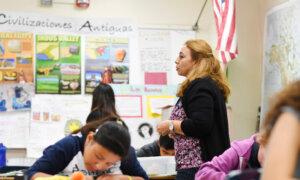Critics say this approach stalls academic progress for students who are still learning English.
In his final days as U.S. secretary of education, Miguel Cardona provided every state governor with a plan he says will improve English language proficiency while still promoting the native languages that 5.3 million students speak at home.
It does not specify a second language, even though Spanish is the native tongue of most English learners (ELs) in the United States.
While some state governors, education leaders, and school board members may be reviewing this playbook, President-elect Donald Trump plans a major overhaul of the U.S. Department of Education.
Still, curriculums are determined at the state and local levels, so the change in administration has little bearing on whether districts choose to implement Cardona’s suggestion for the 2025–2026 academic year or beyond.
“Doing this is important in meeting the strengths and needs of ELs and increasing access to high-quality language programs that maintain their home language while introducing new languages to English-only speaking students.”
The 31-page document refers to districts across a handful of states (California, New York, Texas, Utah, and North Carolina) that already offer dual-language immersion programs and provide guidance on garnering community support, public funding, and staffing initiatives.
It does not outline steps for overhauling the English-only curriculum, nor does it cite any academic metrics or second-language fluency levels of students in existing programs.
Most programs cited involve Spanish, but there are examples of Mandarin Chinese, French, and Vietnamese.
Cardona said this approach is mutually beneficial to native English speakers and those who would learn a second language.
“There are many benefits for students to become multilingual, including a boost to post-secondary and career access, gaining industry language credentials, and connecting to a global economy,” his memo to governors said.
“Just as important are the many benefits to states and their economies. Multilingualism can accelerate the economic viability of your state and can enhance its standing as a desirable destination to invest in business.”
Arizona State School Superintendent Tom Horne, a vocal opponent of dual immersion, said this program would stall language development for English learners and cause them to fall behind in all academic subjects.
Under a voter-approved state law that outlawed such programs in 2000, the English proficiency rate of native Spanish-speaking students across grades K–12 improved from 4 percent to 31 percent in under five years, he said.
The number of native Spanish-speaking students in typical English immersion instruction outnumber their peers in Arizona’s dual-immersion programs by a ratio of four to one.
Horne said he supports bilingualism and wants every student to graduate with fluency in two or more languages.
He said there is no evidence that native English speakers in Arizona’s dual-immersion programs fell behind in any subject due to half of the instruction being provided in Spanish, but with the dual-immersion approach, English learners fell way behind and typically had difficulties meeting graduation requirements across several subject areas.
“Dual immersion is a misnomer,” Horne told The Epoch Times, adding that previously published research found similar failures in programs across the country in the 1980s and 1990s.
“It’s three hours in English and three hours in Spanish, and a lot of students speak Spanish at home.”
“English immersion is there to become proficient in English quickly so they can succeed academically.”
Despite the Arizona law banning dual immersion, known as Proposition 203, several school districts across the state have allowed it.
In 2020, the state Board of Education, with guidance from the Arizona Attorney General’s Office, approved a dual-language model where schools are allowed to provide a half-day of instruction in English and the other half-day in a “partner language.”
Horne said there is ongoing litigation regarding an estimated 10 school districts in the state that have dual-immersion programs.
The playbook said the Seal of Biliteracy program, which recognizes high-performing foreign language students in all 50 states and Washington, lays a solid foundation for expanding schools to dual-language immersion programs.
Seal of Biliteracy awards are based on participation in high school foreign language classes and assessment results; they do not require instruction in an immersive environment or indicate fluency.
Amanda Seewald, executive director of the Joint Committee for Languages, previously told The Epoch Times that, for foreign language classes, most high school students don’t approach fluency levels in a second language due to the lack of instruction time in an immersive environment.
The other major problem, she added, is the severe shortage of foreign language teachers.
In an email response to The Epoch Times, the U.S. Department of Education press office said dual-language immersion programs are more effective than traditional foreign language instruction classes at helping students reach fluency levels because “they are thinking in two languages, and they are engaging in learning in two languages throughout the day.”
“Multilingualism is an economic imperative, and it is a practice promoted by most other countries.”
Original News Source Link – Epoch Times
Running For Office? Conservative Campaign Consulting – Election Day Strategies!


